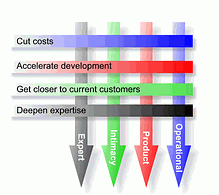In the first half of this two-part series, I examined what has changed in the realm of technology spending, and studied factors that motivate different companies to buy during depressed economic cycles. In this final installment, I'll discuss how to exploit these motivators to pry dollars out of their tight wallets.
Marketing executives must understand the varieties of corporate disciplines to truly understand the motivations of their prospects.
Appealing to functional and emotive motivators, and linking them to your customer's market discipline and current problem or set of problems, is essential to initiating a sale and is reflected in your product and corporate messaging, brochure design, sales campaigns, and even how your receptionist answers the telephone.
The starting point is to list the pressures your prospects most often face in their primary market discipline.
If your target market segments are homogeneous and buyer genotypes are highly similar, then you can renew your marketing strategy broadly across your organization. Otherwise, you need to create a guidebook for your sales staff detailing those customer disciplines and economic motivators at play.
The key to rapidly identifying, qualifying and selling is to find the intersection of the market discipline of your customer and their most pressing issues. The figure presented here is merely an example, and you will want to add more motivating factor rows to the matrix. Find the matrix points that are most relevant to your customers and refocus your marketing strategy and market messages on those points. This will lead you quickly to the most motivated buyers.

Part of refocusing your marketing strategy may require revising your branding. When you begin to evaluate your products and the matrix points that concern your best customers, you may discover that your branding presents the wrong impression.
Borrow A Brain
Indeed, you may discover that there are harmful contradictions (like selling a product to facilitate customer intimacy while presenting your products as being entirely feature driven). Borrow your customer's brain and think about business in terms of their market discipline, then think about your brand. If you don't have a spontaneous warm feeling about your brand, then neither will your prospects.
As Treacy and Wiersema noted, you need to be good at all three disciplines--operational, product and intimacy--but you have to be superb at one. The same applies to your customers. Your branding needs to be focused on the one discipline that is mutually understood and cherished by both organizations. “So, if you want to sell to me...you've got to understand my business, how I make my money and what my problems are." - Roger Krone, VP & GM of Boeing Rotorcraft
From Famine to Feast
Unless your firm is one of the few lucky ones to be in exactly the right market at exactly the right time, then you must change your strategy and change your diet. You can survive and prosper in this lean economy, but it will require you to think like your customers, understand their old disciplines and new pressures, and to change your strategy and branding to meet their limited appetites.



